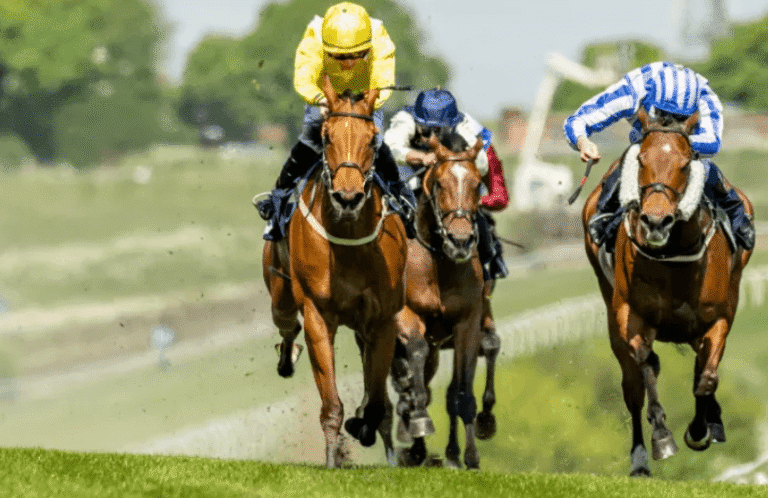Horse racing is one of the world’s oldest and most exciting sports, but for newcomers, the terminology can often feel like a foreign language. From the racetrack to the betting window, understanding the lingo is essential for enjoying the sport fully. Whether you’re a casual fan, a bettor, or simply someone looking to expand their knowledge, learning horse racing terms will help you appreciate the strategy, culture, and thrill of the races.
Here’s a detailed guide to the most important horse racing terms you need to know.
1. General Racing Terms
- Furlong – A unit of distance in horse racing equal to one-eighth of a mile (220 yards or 201 meters). Races are often measured in furlongs.
- Paddock – The area where horses are saddled and paraded before a race.
- Post Time – The official start time of a race.
- Photo Finish – When two or more horses cross the finish line so close together that the winner must be determined by a photograph.
- Silks – The colorful jackets and caps worn by jockeys, representing the horse’s owner.
- Scratch – A horse that has been withdrawn from a race before it begins.
2. Horse Classifications
- Maiden – A horse that has never won a race.
- Colt – A male horse under four years old.
- Filly – A female horse under four years old.
- Mare – A female horse aged four years or older.
- Gelding – A castrated male horse, usually calmer and easier to train.
- Thoroughbred – The most common breed used in professional flat racing.
3. Race Types
- Flat Racing – The most common type of racing, run on a level track without obstacles.
- Steeplechase / Jump Racing – Races that include hurdles, fences, or other obstacles.
- Handicap Race – A race in which horses carry different weights assigned by the handicapper to level the playing field.
- Allowance Race – A race with weight allowances based on the horse’s age, sex, or performance.
- Stakes Race – A high-level race, often with large prize money and featuring top-quality horses.
See also: The Importance of Jockeys in Horse Racing Success
4. Track and Racing Conditions
- Going / Track Condition – The state of the track surface, such as fast, firm, soft, muddy, or sloppy.
- Rail – The inside boundary of the track. Horses starting from an inside position are said to “break from the rail.”
- Post Position – The starting gate number assigned to each horse.
- In the Money – Finishing in first, second, or third place (positions that often pay out in betting).
5. Jockey and Trainer Terms
- Hand Ride – When a jockey encourages the horse using only their hands, without using the whip.
- Under Wraps – When a jockey deliberately holds a horse back from running at full speed.
- Bug Boy – A young apprentice jockey who receives weight allowances to encourage trainers to use them.
- Trainer – The professional responsible for preparing a horse for racing through conditioning, nutrition, and strategy.
6. Betting Terms
- Win – A bet that a horse will finish first.
- Place – A bet that a horse will finish first or second.
- Show – A bet that a horse will finish first, second, or third.
- Exacta – A bet picking the first two horses in the correct order.
- Trifecta – A bet picking the first three horses in the correct order.
- Superfecta – A bet picking the first four horses in the correct order.
- Daily Double – A bet on the winners of two consecutive races.
- Across the Board – A wager covering win, place, and show on the same horse.
- Longshot – A horse with very high odds, considered unlikely to win, but with a large payout if successful.
7. Horse Performance and Running Style
- Front-Runner – A horse that prefers to lead early in the race.
- Closer – A horse that makes a strong late run, often coming from behind.
- Stalker / Presser – A horse that runs just behind the leaders and makes a move in the stretch.
- Breaking Well – A good start out of the gate.
- Drive – The strong effort a horse puts in during the final stretch of a race.
8. Famous Phrases in Racing
- “Down the Stretch” – Refers to the final straight portion of the track leading to the finish line.
- “Neck / Head / Nose” – Terms used to describe winning margins. A “nose” is the smallest possible margin.
- “Pulled Up” – When a jockey stops a horse mid-race due to injury or poor performance.
- “Photo Call” – When the official winner is determined using a finish-line photo.
Conclusion
Horse racing is rich in history, tradition, and unique vocabulary. For newcomers, the jargon may seem overwhelming at first, but once you understand the language, the sport becomes even more thrilling. From learning how to interpret betting terms to recognizing horse classifications and track conditions, these terms are the foundation of the racing world.
Whether you’re at Churchill Downs for the Kentucky Derby, attending Royal Ascot in England, or simply following a local race, knowing the lingo will make the experience far more engaging and enjoyable. Horse racing isn’t just about speed—it’s about strategy, skill, and understanding the game inside and out.
